In the early days of the Thompson Submachine Gun, the Auto-Ordnance Company was looking for customers globally. General John Thompson had personally run a demonstration of the gun in England in June of 1921, which was well received militarily, if not politically. Unfortunately for Thompson, just a few weeks before the trial a plot to smuggle 500 Thompson guns to the IRA on the freighter East Side had been uncovered in New Jersey. This had the not-surprising effect of dampening British interest in working with Thompson and Auto-Ordnance.
However, the company returned to England in 1925 with an interest in licensing production to Birmingham Small Arms. The Belgian military had tested the Thompson in 1923 with favorable results, and had requested a version in 9x19mm with more rifle-like handling. In addition, other European nations looked like good potential customers. The result was the Model 1926 Thompson made by BSA, which used the standard Thompson mechanism (including the Blish lock) but with a redesigned lower and trigger assembly and traditional rifle style stock. It also featured a somewhat smaller forearm and a rear sight unprotected by any wings. Some of the 1926 guns were made with plain muzzles, but the one pictured below has a compensator – this may have been added later or may be original.


It doesn’t appear to be known exactly how many of the Model 1926 guns were made, but it was a very small number. In January 1927, one of them was tested by the French military and performed fairly well. It fired 3500 rounds (including 2500 in fully automatic) and reportedly had only a few minor problems – despite the bolt being found to be broken in half when the gun was disassembled after the test. The rate of fire was a rather fast 1200 rounds/minute, and the French conclusion was that they were not really interested in pistol-caliber submachine guns.
Following this test (and perhaps others), some changes were made to the design, resulting in the Model 1929, also made by BSA. Where the 1926 guns had used barrels with smooth exteriors, the 1929 guns used ribbed barrels and all had Cutts-style compensators as well as protective wings to each side of the (Lyman-made) rear sights. The 1929 model was made in several different calibers, clearly intended to raise interest in different countries. The calibers include 9x23mm Bergmann, 9×19 Parabellum, .45 ACP, and 7.63mm Mauser (in addition, one gun in 7.63mm Mauser was marked .30 Mauser for the British market). It is estimated that only 10-15 of these were made in total, and about half of those remain known today. Specifically, they are:
- #2, .45 ACP
- #4, 9mm Bergmann
- #7, 7.63mm Mauser
- #8, .30 Mauser
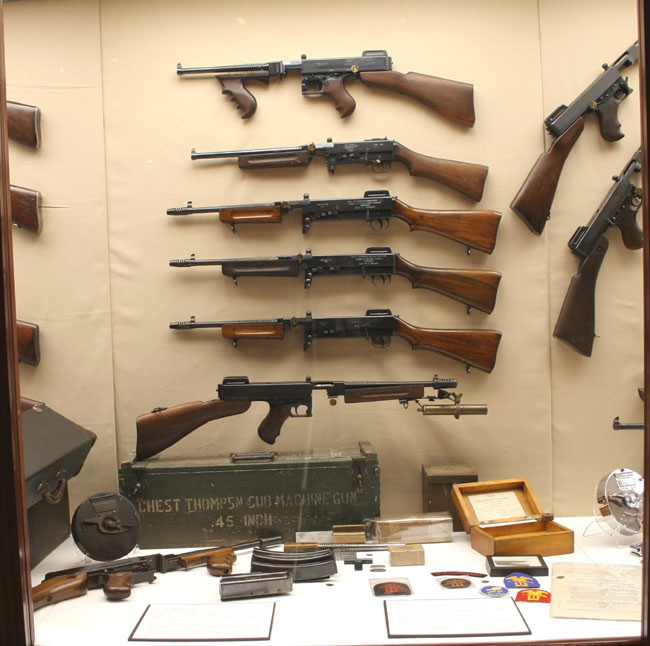
The example in .45 ACP shows a couple variances from the others – a much heftier magazine catch and an awkward-looking reverse angle pistol grip spliced into its stock. The magazine catch makes sense given the much heavier weight of .45 ACP ammunition compared to the smaller offerings, and the gun’s ability to use drums as well as box magazines. The grip was apparently added to facilitate firing from the hip, and is actually not as uncomfortable as it appears.
Ultimately the Model 1929 fared no better than the 1926, and resulted in no contracts. I had an opportunity to examine Model 1929 #2, and took the photographs below. Unfortunately, I was not able to disassemble it for internal photos.












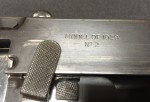




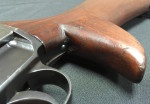


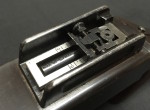



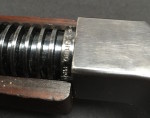
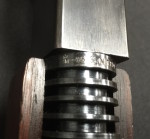


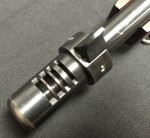
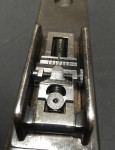
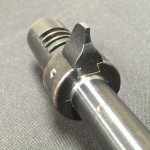
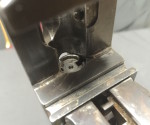
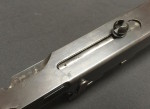
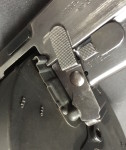
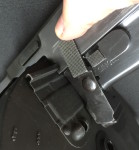
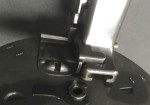

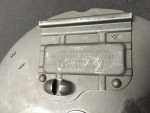
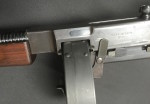
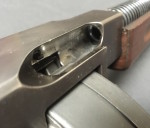
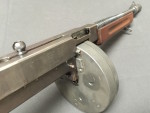
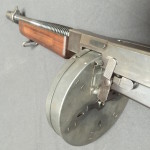
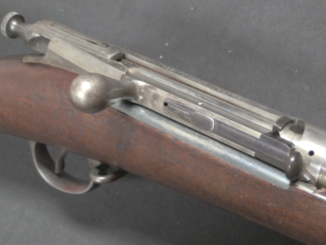
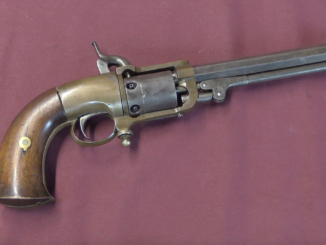
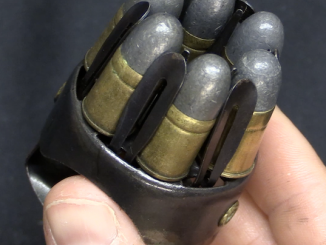
Loved the bit about still firing with a broken bolt. When I got out of the Navy in early ’81 – a few years before the prices on old Harleys went through the roof – I ran across a Joplin MO police-surplus ’51 flathead 45. It had been though several civilian owners but was still mostly original, three-speed shifter on the side of the fatbob tanks, 16″ fat tires front and rear, etc. Wouldn’t do 70 mph if you dropped it out of an airplane but it was more fun at 50 than my Suzuki 1000 was at 125. When I disassembled it that winter I learned that I had done a summer’s daily riding on 3 1/2 valve springs. Good technology is stuff that still works when it is broken.
Did Auto-Ord really make a prototype in .351 Winchester or is that just a gun-nerd legend? Has anyone ever seen a picture?
I have some photos of the 351 version in a book on Thompsons. A friend of mine once wrote an article about oddball Thompsons, including an unfinished prototype chambered in 30-06. He not only had photos of it, but personally examined and handled it.
“In January 1927, one of them was tested by the French military and performed fairly well.”
At this time France used STA M 1922 / MAS M 1924 (firing 9×19)as a sub-machine gun:
http://world.guns.ru/smg/fr/submachine-gun-sta-1922-mas-m-1924-e.html
only around 1000 were made. I think it would be prefer if France would want more sub-machine guns.
“The example in .45 ACP shows a couple variances from the others – a much heftier magazine catch and an awkward-looking reverse angle pistol grip spliced into its stock.”
Interesting evolution – from weapon with separate stock and pistol grip, via weapon without that grip, to weapon with grip and stock blended.
Fast post so please check my info: Some Rem. model 1907 rifles were converted to Thompson look-alikes as shown at
http://oldschoolguns.blogspot.com/2012/03/forgotten-winchester-model-1907.html and some of these were converted to full auto/selective fire models. A conversion is for sale at http://www.armslist.com/posts/1828289/columbus-ohio-rifles-for-sale–winchester-m1907–351cal-20-s–gangster–thompson-style-rifle-w–period-case
The French ordered two Thompsons in .351 as were reportedly advertised in literature from Auto-Ordinance and one was delivered and tested as shown at http://www.smallarmsreview.com/display.article.cfm?idarticles=1599. I know do not know of any that were ever actually delivered in .351 for anything except testing but might be wrong.
Just a funny story about Thompson SMGs in general: our Mother took us to Washington D.C. on two Spring breaks so we could see how the gubbermint works. Back then at Hoovers F.B.I. headquarters, they had an agent fire off a Thompson, and hand out the still hot cartridges as trinkets. I always figured that whatever the FBI wanted, they got. A milled receiver will always be more expensive than a tube with a couple of welds like a STEN.
“milled receiver”
Keep in mind that Thompson was designed near end of WW1, and STEN at beginning of WW2 as a stop-gap weapon, this is about 20 year of difference. In 1920s-1930s no-one think about adopting weapon manufactured with other technique that milling, just look at some interbellum sub-machine guns:
Steyr – Solothurn S1-100
BMP-32 (Bergmann MP32)
Star RU-35
PPD-34
Suomi
MAS-38
ZK-383
“I always figured that whatever the FBI wanted, they got”
Since depression era yes, but if I am not mistaken FBI started rather as data gathering agency.
Up to 1933 Bureau of Investigation “agents” had no arrest powers and were not authorized to carry weapons.
The then director, Gaston B. Means, was a political wheeler-dealer who mainly used the BI as a way of gathering blackmail information to sell to the highest bidder. (See the Sherlock Holmes story, “Charles Augustus Milverton” for a fictional forerunner of Means’ MO.) He had been in that post since the Wilson administration and was part and parcel of the “Palmer raids” in that period.
When FDR came into office, the first thing he did was to fire Means and hire J. Edgar Hoover. The first thing Hoover did was fire most of the Bureau’s field agents (and all of Means’ cronies) and begin recruiting and training a new crop. (This was when a law degree or equivalent became a requirement for the FBI Academy.)
After that, Hoover got clearance from FDR to train and arm his agents.
cheers
eon
Good riddance to Means. I think some of the victims would have liked nothing better than Means staked to the ground and shot to death by Thompson model 1928’s…
Regarding Hoover, a history prof of mine stated that one of Hoover’s best assets was that he had once worked at the library of congress–he knew how to organize a lot of data. Lots of interesting gun lore from the FBI: 38 supers, early 357’s, 10mm H&K’s…and now they’re passing out Glocks, how depressing.
Charles Agustus Milverton was one of my more favorite Sherlock Holmes stories, I have a theory of dating it that goes against Baring-Gould’s date in his annotated volume. Not to hijack the topic, no, wait, that’s it, we’ll hijack the topic until Ian shows more flame thrower videos.
“gun lore from the FBI: 38 supers, early 357’s, 10mm H&K’s…and now they’re passing out Glocks, how depressing.”
Click here: https://www.americanrifleman.org/articles/2011/8/22/a-history-of-fbi-handguns/ to read about history of guns used by FBI.
Notice that despite quite long use of revolvers, they also used .35-cal. Smith & Wesson semi-automatic (Model of 1913) – early automatic pistol, S&W attempt to challenge COLT (COLT POCKET HAMMERLESS .32) and SAVAGE (SAVAGE MODEL 1907 also .32). S&W design was based on European CLÉMENT automatic pistol (few different models were made, fire 5mm Clément cartridge xor 6.35mm Browning /.25 Auto/) but it used own unique cartridge dubbed .35 S&W (with de facto bullet diameter 7,83mm i.e. almost equal to .32 Auto and 7,81mm), despite bought by FBI that automatic pistol become flop commercial-wise for S&W, in part due to peculiar (and more expensive that .32 Auto) cartridge. Later in 1924 S&W tried again to make automatic pistol, now using normal .32 Auto cartridge (see Smith & Wesson .32 Automatic Pistol) but fail to get price level of its competitor and depression also don’t help.
The bottom Thompson in that NRA display has some sort of attachment wing-nutted on under the barrel that looks like a little brass cannon. Anybody know what it is? Some sort of flare/teargas launcher, perhaps?
I found another picture of it and blew it up a bit and smoothed the digital distortion; it looks much like a brass-barreled flashlight. The mounting hardware appears much to fragile to take any measure of recoil produced by any form of launcher that I am aware of. It MIGHT be an adaption of the early practice of using a flashlight as a night-time aiming device for shotguns…put the bright spot on the intended target and let fly. Uncontrolled Thompsons have a well-earned reputation for rather wide dispersion of impacts, or so I have been told. {:>)
Don’t have a whole lot of experience with full-auto weapons (fun, but so retail – nuclear weapons like we carried are the wholesale end of the trade!) but I’ve fired both a M1A1 and a M3A1 owned by Class 3 friends. The Thompson was much cooler but the greaser was a lot more controllable – very easy double- and triple-taps. A Chief Torpedoman I worked for (subs carried Thompsons until the early 70s, a few years before I arrived) who had spent a lot of time burning up the ammo allotment before it hit the expiration date (same excuse I used later for LOTS of M-14 time) called the Thompson a “serious cloud-killer.” Thanks for the .351 info above; I’ve long thought that would have been the ideal cartridge for the M1 carbine, but of course the military couldn’t pass up the urge to issue two weapons called the M-1 which used completely different .30 cartridges. What’s the point of having troops if you can’t baffle them?
as I get to see a little bit of Thompsons – I’m starting to be very unimpressed by them.
Weight – more than an AK
Cost – more than a BAR
Tangent aperture rear sight with windage adjustment is a lovely touch – but on a selective fire .45ACP?
Compensator on the end of a long barrel that’s firing one of the lowest pressure smokeless pistol cartridges – complete waste of time money and effort.
Blish lock – a complete waste of space
1200 rpm! ok, there is precedent for that, as the Villa Perosa was in that sort of territory, but still
Broken bolt!
the long skinny bolt nose does have pros and cons – pros regarding feeding, but cons in terms of length, fragility and difficulty clearing and cleaning.
They’re looking more and more like the work of the same sort of engineers who’s tacticooled AKs Ian shared with us a few weeks back.
Did you have to mention “tacticool” AKs? Generally one needs an expert on gunsmith techniques to customize one’s weapon in a manner that will give a realistically improved and functional performance. Otherwise the custom job looks like some Hollywood reject and performs worse than a Hollywood reject. Given a choice, I’d rather bring a Steyr-Hahn to a dark alley scuffle than an early Thompson. At least the former doesn’t break as easily.
“1200 rpm! ok, there is precedent for that, as the Villa Perosa was in that sort of territory, but still”
Villar Perosa was designed as a aircraft weapon, low mass compared to full-power cartridge machine gun because early aeroplanes have small payload, pistol cartridge might then look as big enough to destroy enemy aeroplanes (look at aeroplane used in 1914) and high Rate-Of-Fire was also advantage (better chance to hit moving target)
“Broken bolt!”
Ok, but we don’t know reason: flawed blueprints xor flawed workmanship?
“They’re looking more and more like the work of the same sort of engineers who’s tacticooled AKs Ian shared with us a few weeks back.”
Still keep in mind that Thompson sub-machine gun was designed near end of WW1, when no-one was sure how sub-machine gun should looks. Austria-Hungary fielded this:
https://www.youtube.com/watch?v=k6KGXpiN4Mk
it is known as Stop M.17
yes, it is twin linked tripod mounted sub-machine gun firing 7.65mm Frommer (.32 Auto hot-loaded) cartridge. It was factory made, notice serious depart from basic Frommer Stop: it has no more trigger and trigger-guard where they were, longer barrel, different magazine release, some internal detail also were altered. Bigger magazine were made (capacity: 25 or 30). It was produced in small amount. I wonder about cyclic rate-of-fire of this weapon.
I hope that now Thompson sub-machine gun looks more sane to you.
Steyr-Hahn also was used for creating twin/full-auto-capable*/higher-capacity weapon:
http://qsy-complains-a-lot.tumblr.com/post/124407722888/miniaturesandcostumes-twin-steyr-191216
magazine capacity 16 rounds
* if I am not wrong: Frommer M.17 was full-auto-only when Steyr was selective-fire weapon, though I’m not sure, can anyone approve or deny it?
The 1928 M1928A1 had a reduced cycle time and proved much more controllable with its 600-750 rpm rate of fire. A semi-auto selection made it easy to get off single rounds (making the aperture rear sight advantageous) while the full-auto selection enabled double- and triple-tap bursts or a “fire-hose” burst. It was far superior to the BAR (which I seem to remember from the dim past) in a close-quarter engagement such as urban warfare settings as well as close-in jungle settings where “swing rate” was a great plus. (Ever tried to turn around in a doorway holding a broom handle … analogous to a BAR in a structure clearing operation where the Thompson excelled) The .45 also had plenty of stopping power at close range. These were never intended to serve as Main Battle Rifles; they were first developed for trench warfare and had their place just like all other successful weapons. My other main admiration for the .45 ACP Thompson was that, like other successful SMGs, it fired the standard pistol cartridge of the users (USMC). I always carried a .45 1911A1 so that was and still is a plus for me. They remind me of my dog, ugly as Hell, often smells bad but loyal as can be and never has failed me yet.
The Barrow gang prefered the BAR in terms of firepower,reliability and availability. You could cut a BAR down into a quick handling whip-it-gun. I’m shure it would probably weigh about as much as the Thompson. I don’t think that the Thompson is a ugly gun. The 1921 is my favorite especially with the Cutts compensator. Honestly there’s nothing quite like the sound of a 1921 ripping off a long burst. Sweet music.
“You could cut a BAR down”
Photos: http://texashideout.tripod.com/scatgun.html
I agree that you can cut a BAR down and know about the Barrows and others using it but could never quite figure out how to get a .30-06 round to function through my 1911A1. {:>)
A 30-06 in a 1911A1 frame sounds scary to me. I guess you could make it fit with a hammer. I understand the appeal of a carbine or sub gun that uses the same ammo as your favorite pistol. I’ve often rattled around the thought of a 9mm carbine match for my CZ75,a 357mag lever gun for my 38spl Colt OP and Detective special,and a AMT automag III for my Inland carbine. I think I’ll go for the AMT In the future.
“9mm carbine”
Then check: http://www.chiappafirearms.com/product/2679
Once bought an shot out 1892 Winchester in .32-20 and had P. O. Ackley convert it to .357 Mag. to go with my S&W in that cal. It was a fantastic close-range deer rifle in the surrounding swamps where I hunted and took several deer with both. It was pretty good medicine for an angry hog as well.
I am very interested in how the reverse horn grip would work. Definitely not a common feature for sure. What camera do you use to take these pictures Ian?
I actually used an iPhone 6+ for these photos.
A neat Thompson development prototype that I did’nt know about. So the British government was unhappy about the 500 Thompsons that were seized. The IRA still received Thompsons. I wonder how many 1921’s they ended up with.
Enough to win independence. 🙂
Just have seen video with Broomhandle in full auto – that is an efficient design in my mind.
As for Mr. Thompson and his invention – I can see his thorny way before adoption; everything has to be deserved, I guess.
I noticed that the model’s that they were considering all have a visibly different silhouette from those that the IRA DID have and field. may have part of their considerations an attempt to reduce False Flag strikes by the IRA?
gee I love that my keyboard stutters and makes me sound like a goon, please read a “been” between considerations and an attempt above. thank you!
From several photos of caches in Ireland they actually got ahold of the Thompson Destroyer. The original trench broom concept with no provision for a but stock and the 100 round drum.
A really interesting Thompson variant. It would be great if a comparison video could be made one day against the original Thomspon to understand and see the differences in the receiver design.